The New York State Avian Records Committee (hereafter NYSARC or the
Committee) made decisions on a total of 94 reports involving 44 species.
These included 75 reports from 1999, 2 third-round reports from 1997,
17 second-round reports from 1998. In all, 65 reports (69%) were accepted.
This is slightly lower than average but reflects the unusually large
number of reports in this batch that were undergoing second or even third
review cycles. Twenty-five submissions were not accepted because of insufficient
documentation or because the descriptions were inconsistent with known
identification criteria. Multiple reports were received for only 20%
of sightings, although co-observers were often mentioned. All records
reviewed by NYSARC (including descriptions, photographs, videotapes,
audio recordings, and Committee comments) are archived at Cornell University
in Ithaca. Reports are reviewed by the seven voting members of the committee
and voted upon as outlined in McGowan and Burke 2000.
How complete is our coverage? An informal survey of the ten Regional
Reports in The Kingbird identified more than 70 reports of species or
subspecies on the NYSARC review list that were not submitted to the Committee.
This included a large number of multi-observer sightings. As we endeavor
to make it easier for birders to submit reports via electronic media,
it is hoped that the mediocre submission rate will improve substantially.
Local bird clubs can help us in this regard by distributing information
about the review process to members and all Regional Editors should demand
submission of documentation before incorporating state rarities into
their reports.
Counties best represented by accepted reports are Niagara and Suffolk,
both with 15, Seneca following with 10. In total, the committee reviewed
reports from 32 counties. All records are sight records unless otherwise
indicated. For accepted reports, the names of observers submitting documentation
are given in parenthesis and the names of all contributors are listed
in full at the end of the report. Occasionally, the names of the original
finders (when known) are given in the narrative. The records in this
report are arranged taxonomically following The AOU Check-List of North
American Birds (AOU 1998). Those contributing photographs, video or sketches,
are given special mention in the narrative. With the rapid advances in
affordable camera equipment, we anticipate an increase in the number
of scarce or rare species documented by photographs or video. Photographs
do not need to be 'magazine quality' for them to be extremely useful
in supporting a written description. Similarly, we will gladly accept
copies of video or audiotapes accompanied by a written report.
A common misconception persists that only the initial discoverer of
a bird may submit a report. In actuality, all observers of a rarity (even
if the bird is seen by hundreds of people) are urged to submit written
descriptions or other forms of documentation (e.g. photographs, video
or sketches). As a rule of thumb, one should never assume that others
will submit a report or any other documentation. This may account for
the large number of multi-observer sightings that go undocumented. Submission
of multiple independent reports provides a much more compelling and detailed
account of the sighting, increasing the likelihood of acceptance.
Information on how to prepare and submit
a report, together with an up-to-date list
of species reviewed by NYSARC, is posted on the Federation
of New York State Bird Clubs web site (https://nybirds.org/NYSARC/index.htm).
This site includes information about the Committee and
a photo gallery of recent submissions,
including some of those published in this report. NYSARC encourages
observers to submit documentation for all species on the review list,
as well as species unrecorded in New York. Documentation or correspondence
for the Committee should be sent to:
Jeanne Skelly
Secretary for NYSARC
420 Chili-Scottsville Road
Churchville, NY 14428
E-mail:
Among the highlights of 1999 were two species new to the New York State
Checklist, Black-tailed Gull (Larus crassirostris) and MacGillivray's
Warbler (Oporornis tolmiei). With these inclusions, the state
list rises to 456 species. Other notable highlights include the second
live occurrence of Yellow-billed Loon (Gavia adamsii) and the
second record of Spotted Redshank (Tringa erythropus). A Mew Gull
(Larus canus) of the Eurasian subspecies canus constitutes the
first record away from the Niagara or St. Lawrence Rivers and first state
record documented by photography or other physical evidence. Photo-documented
records of two or perhaps three White-faced Storm-Petrels (Pelagodroma
marina) off Long Island mark an exceptional season for this species.
NYSARC is indebted to the seventy-three observers who contributed the
reports discussed here. Several individuals put forth considerable effort
to document important sightings for the permanent record and where possible,
their efforts are acknowledged in the narratives below. Unfortunately,
these seventy-three contributors represent a tiny minority of the many
hundreds, if not thousands, of active birders and feederwatchers in the
state. Hopefully we will see increased participation in the reporting
process in future years.
1999
Reports Accepted
Yellow-billed Loon (Gavia adamsii)
1999-2-A/B/C/D/E One in West Canada Creek below the Hinkley Reservoir
Dam in Town of Trenton, Oneida Co. and Town of Russia in Herkimer Co.,
20-30 Jan (Dorothy Crumb, Gerry Rising, William W. Watson, Yolanda
Garcia, David J. and Candis C. Cesari). This magnificent bird was documented
with an excellent series of reports and supported by an informative
color sketch by Yolanda Garcia and photographs by David Cesari. The
loon was first discovered on 18 Jan, by Matt Perry, in the narrow confines
of an ice-free stretch of the West Canada Creek shortly after it emerges
from the Hinkley Reservoir Dam. . This is the third record for New
York State and second live sighting. Many birders from the Northeast
enjoyed this rare sight. The previous winter, a juvenile or possibly
first-basic Yellow-billed Loon visited Oswego Harbor, also in Region
5 (Phillips, 1998). The extreme rarity of this species in the Northeast
and relative proximity of the two sightings (less than 70 miles apart)
led to speculation that the same individual was involved. The Oswego
loon appeared to be in juvenile plumage, while the Hinkley Dam bird
was a sub-adult, most likely a second-year, judging by the absence
of small white spots on the wing-coverts, which are inconsistent with
definitive-basic 'adult' plumage. Photos
below copyright of Angus Wilson.


Western Grebe (Aechmophorus occidentalis)
1999-47-A One on Niagara River off McFarland Point Ontario and Village
of Youngstown, Niagara Co., NY on 27 Nov (Donald Ford). This well-described
bird was first spotted from the Ontario side of the Niagara River.
Although Aechmophorus grebes are fairly distinctive, the identification
of birds as either Western or Clark's Grebe (A. clarkii) is
not always straightforward. The two are sufficiently similar that some
may be unidentifiable, particularly non-breeding birds. However, the
observers of the Niagara grebe noted that the dark cap extended below
the lores and the eyes which is consistent with Western Grebe.
White-faced Storm-Petrel (Pelagodroma marina)

 1999-30-A
One or possibly two, at sea over the Hudson Canyon (39.6931; -72.5819)
28 Aug (Shawneen Finnegan); 1999-31-A One at sea approximately 20 miles
due south of Montauk Point, Suffolk Co., 9 Sep (Jack Passie). The summer
of 1999 marked a banner year for White-faced Storm-Petrels off the
eastern seaboard. Both reports from New York waters were accompanied
by excellent descriptions and supported by video by Shawneen Finnegan
(1999-30-A) and color photographs by Jack Passie (at right) and Dave
Johnston (1999-31-A). In spite of the lone report, the Hudson Canyon
bird(s) was enjoyed by a large number of New York birders participating
in an organized pelagic trip. This unique species breeds on remote
islets in the eastern North Atlantic as well as in the southern oceans.
Two subspecies occur in the North Atlantic; P. m. hypoleuca which
breeds on the Selvagen archipelago in the northern summer and P.
m. eadesi which breeds on the Cape Verde Islands off West Africa.
Which subspecies occurs in New York waters remains an interesting and
unanswered question. Those breeding on the Selvagens return to their
colonies in February where most remain until September. In contrast, P.
m. eadesi breeds during the northern winter arriving at the breeding
sites from November onwards. Although this would suggest New York records
pertain to Cape Verde birds, the movements of nonbreeding hypoleuca remain
completely unknown. Photos copyright of
Jack Passie. Click to enlarge.
1999-30-A
One or possibly two, at sea over the Hudson Canyon (39.6931; -72.5819)
28 Aug (Shawneen Finnegan); 1999-31-A One at sea approximately 20 miles
due south of Montauk Point, Suffolk Co., 9 Sep (Jack Passie). The summer
of 1999 marked a banner year for White-faced Storm-Petrels off the
eastern seaboard. Both reports from New York waters were accompanied
by excellent descriptions and supported by video by Shawneen Finnegan
(1999-30-A) and color photographs by Jack Passie (at right) and Dave
Johnston (1999-31-A). In spite of the lone report, the Hudson Canyon
bird(s) was enjoyed by a large number of New York birders participating
in an organized pelagic trip. This unique species breeds on remote
islets in the eastern North Atlantic as well as in the southern oceans.
Two subspecies occur in the North Atlantic; P. m. hypoleuca which
breeds on the Selvagen archipelago in the northern summer and P.
m. eadesi which breeds on the Cape Verde Islands off West Africa.
Which subspecies occurs in New York waters remains an interesting and
unanswered question. Those breeding on the Selvagens return to their
colonies in February where most remain until September. In contrast, P.
m. eadesi breeds during the northern winter arriving at the breeding
sites from November onwards. Although this would suggest New York records
pertain to Cape Verde birds, the movements of nonbreeding hypoleuca remain
completely unknown. Photos copyright of
Jack Passie. Click to enlarge.
Tricolored Heron (Egretta tricolor)
1999-19-A One, southern end of Motor Island in the Niagara River, Town
of Tonawanda, Erie Co., 2 Jun (William Watson); 1999-22-A One on Tschache
Pool at Montezuma National Wildlife Refuge, Town of Tyre, Seneca Co.,
8 Jul (Benjamin Fambrough). A predominantly coastal species, Tricolored
Herons are common summer visitors to Long Island, but very rare elsewhere,
particularly in northern and western parts of the state.
Black Vulture (Coragyps atratus)
1999-20-A One over Derby Hill, Town of Mexico, Oswego Co. on 31 Mar (Bill
Purcell); 1999-40-A One over Wooley Hill Hawk Watch, West Burlington,
Town of Burlington, Otsego Co., 21 Oct (Tom Salo). Two well-described
birds observed from hawkwatches. Tom Salo's comprehensive report of
the Wooley Hill bird included helpful field sketches of the head and
underwing pattern, clearly eliminating Turkey Vulture (C. aura).
During the last decade, Black Vultures have undergone a major range
expansion, particularly in southern parts of the state such as along
the Hudson River Valley. Because of this sustained change in status,
NYSARC has dropped this species from the review list (NYSARC 2000).
This said, the species remains very rare in western New York, and full
documentation should be submitted to local records committees from
that area.
Ross's Goose (Chen rossii)
1999-35-A One in field near Point au Roche State Park, Town of Beekmantown,
Clinton Co., 8 Oct (David J. Hoag); 1999-37-A/B One on May's Point
Pool, Montezuma National Wildlife Refuge, Town of Tyre, Seneca Co.,
14 Oct (William W. Watson, Michael F. Galas); 1999-39-A One to three
Treadwell Bay, Point au Roche State Park, Clinton Co., 29 Oct (David
J. Hoag); 1999-43-A One at Monty Bay, north of Point au Roche State
Park, Clinton Co., 11 Nov (David J. Hoag). Each fall and winter, David
Hoag searches the thousands of Snow Geese that pass through the upper
reaches of Lake Champlain (both in New York and Vermont) for color-marked
birds. As a by-product of these valuable studies, Hoag has revealed
the regular occurrence of small numbers of Ross's Geese as well as
numbers of possible Ross's x Snow Goose hybrids. Reports of this primarily
western species have increased dramatically in eastern North America
during the last two decades (Ryder and Alisauskas 1995). The first
record for NY occurred in March 1983 (Treacy 1983) and the species
has become annual. With good views, Ross's Goose is readily separable
from Snow Goose (C. caerulescens) and the primary identification
challenge is that of Ross's x Snow Goose hybrids. We urge that potential
Ross's Goose reports be carefully documented with an emphasis on bill
and head characteristics which are needed to eliminate the possibility
of hybrids (Trauger et al., 1971, Roberson, 1993).
Mississippi Kite (Ictinia mississippiensis)
1999-26-A One on Great Gull Island, Suffolk Co., 26 Jul (Dick Young).
Detailed description (supplemented with sketch) of an adult or perhaps
subadult seen flying over the large Common Tern colony. Great Gull
Island covers 17 acres and lies 7 miles east of Orient Point. The island
serves as a regular stepping stone for migrant raptors, including a
long-staying Swainson's Hawk (Buteo swainsoni) in 1998 (NYSARC
1998-50-A). This is the second record of Mississippi Kite for Great
Gull Island, the first being an immature on 25 May 1991 (1991-41-A/B).
Sandhill Crane (Grus canadensis)
1999-9-A One near the Montezuma Wetlands Complex Headquarters, Town of
Tyre, Seneca Co., 11 Apr (Catherine I. Sandell); 1999-11-A Two near
intersection of Rt 63 and Dunlop Road, Town of Shelby, Orleans Co.,
29 Apr (Richard Sowinski); 1999-12-A One off the Klossen Marsh trail
in the Tonawanda Wildlife Management Area, Town of Alabama, Genesee
Co., 1 May (Willie D'Anna); 1999-21-A One on West River at the south
end of Canandaigua Lake, Town of Italy, Yates Co., 28 Jun (Catherine
I. Sandell). Reports of Sandhill Cranes have become increasingly common
during the past decade or so, especially from western parts of the
state and along the southern shore of Lake Ontario. Because of this
sustained increase in occurrence, the species was removed from the
NYSARC review list (NYSARC 2000).
Spotted Redshank (Tringa erythropus)
1999-25-A Adult in alternate plumage, near Dune Road east of the Ponquogue
Bridge, Shinnecock, Suffolk Co., 19 Jul (Rex G. and Birgit Stanford).
The Spotted Redshank was discovered at high tide as it roosted with
several Greater Yellowlegs (T. melanoleuca) and American Oystercatchers
(Haematopus palliatus) in the salt marsh east of the Ponquogue
Bridge. After several minutes of observation, during which time it
was photographed, the redshank flew into longer marsh grass and could
not be relocated. Aberrantly dark (melanistic) Greater and Lesser yellowlegs
(T. flavipes) and potential vagrants such as Common Redshank
(T. totanus) were excluded by the combination of blackish plumage,
white uppertail coverts and lower back, deep red legs and lack of white
secondaries or inner primaries. A detailed written description was
supported by a distant, but helpful, color photograph taken by Rex
Stanford using a conventional single lens reflex camera held to the
eyepiece of his telescope. This is the first acceptable record of this
attractive Eurasian shorebird since the individual that spent two consecutive
winters (1992/93 and 1993/94) in Sheepshead Bay, Brooklyn, Kings Co.
Marbled Godwit (Limosa fedoa)
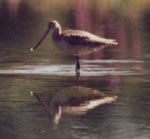
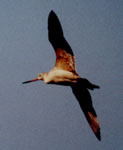
 1999-32-A
One Point Peninsula Shoal, Town of Lyme, Jefferson Co., 30-31 Aug (Nick
Leone, photographed by Lee Chamberlaine). Annual in small numbers on
Long Island, Marbled Godwit remains rare elsewhere in the state. The
Point Peninsula bird frequented a small island with a limestone shoreline,
short sections of sandy beach and stagnant pools. The bird was studied
at close range over a two-day period and also photographed by Don Johnston.
This excellent report included a careful description of the cinnamon
underwing coverts and axillaries thereby eliminating all other species
of godwit. Photos copyright of Lee Chamberlaine.
Click to enlarge.
1999-32-A
One Point Peninsula Shoal, Town of Lyme, Jefferson Co., 30-31 Aug (Nick
Leone, photographed by Lee Chamberlaine). Annual in small numbers on
Long Island, Marbled Godwit remains rare elsewhere in the state. The
Point Peninsula bird frequented a small island with a limestone shoreline,
short sections of sandy beach and stagnant pools. The bird was studied
at close range over a two-day period and also photographed by Don Johnston.
This excellent report included a careful description of the cinnamon
underwing coverts and axillaries thereby eliminating all other species
of godwit. Photos copyright of Lee Chamberlaine.
Click to enlarge.
Black-tailed Gull (Larus crassirostris)


 1999-79-A
Adult near Parking Lot 6, Jones Beach State Park, Nassau Co., 31 Jan-1
Feb (Wilson and.Guthrie 1999). This constitutes the first record for
New York State. The Black-tailed Gull was discovered loafing on the
ocean beach late in the afternoon on 31 Jan by Andrew Guthrie and Angus
Wilson. As dusk descended it moved further down the beach and then
onto the ocean to roost with several thousand other gulls. To the relief
and enjoyment of many local birders, the Black-tailed Gull was still
present the following day, squabbling for handouts in Parking Lot 6
amid the usual Herring Gulls (L. argentatus) and Ring-billed
Gulls (L. delawarensis). With records from Nova Scotia to Florida
(Lethaby and Bangma 1999), the regular occurrence of this Asiatic gull
on the East Coast of North America remains puzzling. Photos
copyright of Rex Stanford. Click to enlarge.
1999-79-A
Adult near Parking Lot 6, Jones Beach State Park, Nassau Co., 31 Jan-1
Feb (Wilson and.Guthrie 1999). This constitutes the first record for
New York State. The Black-tailed Gull was discovered loafing on the
ocean beach late in the afternoon on 31 Jan by Andrew Guthrie and Angus
Wilson. As dusk descended it moved further down the beach and then
onto the ocean to roost with several thousand other gulls. To the relief
and enjoyment of many local birders, the Black-tailed Gull was still
present the following day, squabbling for handouts in Parking Lot 6
amid the usual Herring Gulls (L. argentatus) and Ring-billed
Gulls (L. delawarensis). With records from Nova Scotia to Florida
(Lethaby and Bangma 1999), the regular occurrence of this Asiatic gull
on the East Coast of North America remains puzzling. Photos
copyright of Rex Stanford. Click to enlarge.
Mew Gull (Larus canus)
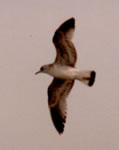
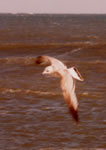
 1999-4-A/B/C
One in first-basic plumage at the Shinnecock Inlet, Suffolk Co., 6
Feb-23 March (Anthony J. Lauro, John J. Fritz, Joan L. Quinlan). Although
there are four subspecies of Mew Gull, the Shinnecock individual showed
a suite of characters consistent with the European subspecies L.
c canus, a distinctive form known in the European literature as
the "Common Gull". Brief written descriptions were supported
by a series of color photographs taken by John Fritz, Joan Quinlan
and Angus Wilson. Separation of Mew Gulls and Ring-billed Gulls (L.
delawarensis) is subtle and must take into account a combination
of structural and plumage features. Key features in the identification
of the Shinnecock bird were the smaller size, structure and color of
the bill, sharply demarcated black subterminal tail band, relatively
muted upperwing pattern and precise patterning of the upper wing coverts.
The gull made irregular appearances at the inlet for several weeks
and was seen by many observers. Where it spent its time when not at
the inlet remains a mystery. For a more detailed account with photos
see Guthrie
et al., 1999. Common Gull is a rare but increasing regular visitor
to eastern North America. The majority of records come from the maritime
provinces of Canada suggesting immigrants from Iceland (first colonized
in 1955) or the Faeroe Islands. This hypothesis is supported by an
individual in Newfoundland that was banded as a chick in northern Iceland.
The Shinnecock bird constitutes the first record of Mew Gull in New
York away from the Niagara or St. Lawrence rivers. This is also the
first New York occurrence to be documented by photography or other
physical evidence. Photos copyright of
John J. Fritz and Joan L. Quinlan. Click to enlarge.
1999-4-A/B/C
One in first-basic plumage at the Shinnecock Inlet, Suffolk Co., 6
Feb-23 March (Anthony J. Lauro, John J. Fritz, Joan L. Quinlan). Although
there are four subspecies of Mew Gull, the Shinnecock individual showed
a suite of characters consistent with the European subspecies L.
c canus, a distinctive form known in the European literature as
the "Common Gull". Brief written descriptions were supported
by a series of color photographs taken by John Fritz, Joan Quinlan
and Angus Wilson. Separation of Mew Gulls and Ring-billed Gulls (L.
delawarensis) is subtle and must take into account a combination
of structural and plumage features. Key features in the identification
of the Shinnecock bird were the smaller size, structure and color of
the bill, sharply demarcated black subterminal tail band, relatively
muted upperwing pattern and precise patterning of the upper wing coverts.
The gull made irregular appearances at the inlet for several weeks
and was seen by many observers. Where it spent its time when not at
the inlet remains a mystery. For a more detailed account with photos
see Guthrie
et al., 1999. Common Gull is a rare but increasing regular visitor
to eastern North America. The majority of records come from the maritime
provinces of Canada suggesting immigrants from Iceland (first colonized
in 1955) or the Faeroe Islands. This hypothesis is supported by an
individual in Newfoundland that was banded as a chick in northern Iceland.
The Shinnecock bird constitutes the first record of Mew Gull in New
York away from the Niagara or St. Lawrence rivers. This is also the
first New York occurrence to be documented by photography or other
physical evidence. Photos copyright of
John J. Fritz and Joan L. Quinlan. Click to enlarge.
California Gull (Larus californicus)
1999-41-A/B One adult on lower Niagara River, Devils Hole State Park,
Town of Lewiston, Niagara Co., 7 Nov (Willie D'Anna, Brendan Klick);
1999-42-A/B One adult Niagara River, Devil's Hole State Park, Town
of Lewiston, Niagara Co., 8-9 Nov (Michael F. Galas, William Watson);
1999-45-A One adult on lower Niagara River, Robert Moses Power Plant,
Town of Lewiston, Niagara Co., 21, 26, 27 Nov (Willie D'Anna); 1999-49-A
One adult on lower Niagara River, Robert Moses Power Plant, Town of
Lewiston, Niagara Co., 4, 11-12 Dec (Willie D'Anna); 1999-53-A/B One
adult and one third-basic on 'roosting' rocks in the lower Niagara
River, Devils Hole State Park, Town of Lewiston, Niagara Co., 26 Dec(Willie
D'Anna, Brendan Klick). The Niagara Frontier remains the premier locality
for this western species in New York State. It is unclear exactly how
many individuals were involved in this year's series of nine reports
- certainly a minimum of two. On 26 Dec, D'Anna and Klick observed
an adult and a third-basic standing close to one another on exposed
rocks in Devils Hole State Park, a short distance upstream of the Robert
Moses Power Plant , a favored locality. Following the first record
in 1992, one or two California Gulls have been logged each winter on
the Niagara River, the majority involving adults (reviewed in D'Anna
2000).
Arctic Tern (Sterna paradisaea)
1999-14-A One Chazy River Landing (or Chazy Riverlands) on Lake Champlain,
Town of Champlain, Clinton Co., 10 May (William E. Krueger). Careful
study of this lone tern roosting with Ring-billed Gulls (L. delawarensis)
noted the unmarked red bill and projection of the tail beyond the primary
tips. Presumably this individual was following an inland route towards
its breeding grounds in arctic Canada. There are only a handful of
acceptable records for this species in spring or early summer.
Ash-throated Flycatcher (Myiarchus cinerascens)
1999-44-A One at Fort Tilden, Queens Co., 20 Nov (Dale Dyer). Studied
by a group of twenty or more observers but only one report submitted.
Fortunately, this clear description ruled out other Myiarchus flycatchers.
The late fall date is fairly typical for this western species.
Western Kingbird (Tyrannus verticalis)
1999-36-A/B/C/D One on Overlook Lane, Hamlet of Meadowdale, Town of Guilderland,
Albany Co., 11-17 Oct (Lawrence Alden, Barbara Putnam, Robert E. Budliger,
Walter G. Ellison). Present for at least a week, this Western Kingbird
was studied by numerous local birders and described in detail in the
four reports received, supplemented with field sketches and notes by
Ellison. All four reports noted the white outer rectrices, a distinctive
feature of this species that is not found in other North American kingbirds.
Cassin's (T. vociferans), Couch's (T. couchii) and Tropical
Kingbird (T. melancholicus) were further eliminated by the lack
of a sharp contrast between the whitish malar area and pale gray breast,
relatively slender bill and paler green coloration on the mantle. Lack
of emargination on the outer primaries noted by Ellison, indicates
a first-year bird. Western Kingbirds are regular fall migrants to coastal
New York but remain much rarer inland.
Mountain Bluebird (Sialia currucoides)
1999-38-A One in the Rocky Point Natural Resources Management Area, Suffolk
Co., 27 Oct (Joel L. Horman). A female-type accompanied by several
Eastern Bluebirds (S. sialis) studied for a few minutes in an
open clearing.
Yellow-throated Warbler (Dendroica dominica)
1999-17-A One Golden Hill State Park, Town of Somerset, Niagara Co.,
15 May (Willie D'Anna); 1999-46-A One at private residence, East Main
Street, West Winfield, Herkimer Co., 24 Nov (C. Kendall Zoller); 1999-55-A
One visiting feeders in two private yards in Skaneateles, Onondaga
Co., 13-27 Dec (Dorothy W. Crumb, photos by Robin Jowaisas). The Skaneateles
bird was observed at two different feeders (1.5 miles apart) on East
Lake Road. Although not seen by experienced birders, the homeowners
supplied good verbal descriptions to Dorothy Crumb who submitted the
report. Most importantly, the record was documented by color photographs
taken by Robin Jowaisas, whose feeder hosted the bird from 13-18 Dec.
On the night of the last sighting when temperatures fell below zero,
the warbler was seen by homeowner Linda Pietroski as it huddled near
a suet feeder. Its ultimate fate is unknown. The Golden Hill State
Park bird was found by Michael Morgante and Michael Turisk. The report
from Herkimer Co. required two rounds of review due to the brevity
of the description. The information supplied is, however, consistent
with Yellow-throated Warbler and the tendency of this species to appear
in the fall is also supportive. An earlier report of this bird from
October was too vague to evaluate. This southern species is a regular
spring overshoot to New York State, most frequently to the Delaware
River Valley and urban parks in the New York City area. Records anywhere
from more northern parts of the state or from the late fall and winter
remain notable.
MacGillivray's Warbler (Oporornis tolmiei)

 1999-52-A/B
One, Mohlenoff Nursery, Victory Boulevard, Staten Island, Richmond
Co., 15-28 Dec (Richard R. Veit, Michael Higgiston). This constitutes
the first record for New York State. Discovered by Dick Veit as he
searched for Orange-crowned Warbler (Vermivora celata) and Nashville
Warbler (V. ruficapilla) reported from the nursery a few days
earlier. The MacGillivray's Warbler frequented weedy vegetation growing
in and around some disused greenhouses but regularly ventured into
scrubby vegetation surrounding a stand of Norway Spruce. Although elusive,
the bird could be tracked through the vegetation by its regular calls.
Mourning Warbler (O. philadelphia) was eliminated by the call
note, throat color and shape of the white eye crescents. After review
of museum specimens, Veit tentatively identified the bird as a hatching
year male on the basis of the blackish rather than grayish lores. Over
the next few days, the bird was seen by many local birders and recording
made of the call note. See Veit and Taylor, 2000 for a detailed account
of this sighting including two photographs by Steve Nanz. This species
was long overdue in New York. In the Northeast, MacGillivray's Warbler
has been recorded in Massachusetts (seven records) and New Jersey (one
record). Specimen records from Rhode Island and Connecticut await ratification
by the appropriate state committees. Photos
copyright of Steve Nanz. Click to enlarge.
1999-52-A/B
One, Mohlenoff Nursery, Victory Boulevard, Staten Island, Richmond
Co., 15-28 Dec (Richard R. Veit, Michael Higgiston). This constitutes
the first record for New York State. Discovered by Dick Veit as he
searched for Orange-crowned Warbler (Vermivora celata) and Nashville
Warbler (V. ruficapilla) reported from the nursery a few days
earlier. The MacGillivray's Warbler frequented weedy vegetation growing
in and around some disused greenhouses but regularly ventured into
scrubby vegetation surrounding a stand of Norway Spruce. Although elusive,
the bird could be tracked through the vegetation by its regular calls.
Mourning Warbler (O. philadelphia) was eliminated by the call
note, throat color and shape of the white eye crescents. After review
of museum specimens, Veit tentatively identified the bird as a hatching
year male on the basis of the blackish rather than grayish lores. Over
the next few days, the bird was seen by many local birders and recording
made of the call note. See Veit and Taylor, 2000 for a detailed account
of this sighting including two photographs by Steve Nanz. This species
was long overdue in New York. In the Northeast, MacGillivray's Warbler
has been recorded in Massachusetts (seven records) and New Jersey (one
record). Specimen records from Rhode Island and Connecticut await ratification
by the appropriate state committees. Photos
copyright of Steve Nanz. Click to enlarge.
To see more of Steve's bird photos, see the Steve
Nanz website.
Nelson's Sharp-tailed Sparrow (Ammodramus nelsoni)
1999-33-A/B/C One on Esker Brook Trail, Montezuma National Wildlife Refuge,
Town of Tyre, Seneca Co., 11 Sep (Patricia Kocinski, Randi Minetor,
Diane Henderson). Cumulatively these three descriptions made a convincing
case for a first-year Nelson's Sharp-tailed Sparrow, adequately ruling
out Saltmarsh Sharp-tailed Sparrow (A. caudacutus), LeConte's
Sparrow (A. leconteii) and basic-plumaged Bobolink (Dolichonyx
oryzivorus). Due to minor differences between the three descriptions,
the reports required two rounds of review and the Committee was unable
to conclude which subspecies of Nelson's Sharp-tailed Sparrow (nelsoni,
alterus or subvirgatus) was involved. The status and distribution
of Nelson's Sharp-tailed Sparrow in New York remains poorly understood
and very little is known about the occurrence of each subspecies. NYSARC
strongly encourages detailed documentation of candidates with special
attention to subspecies. Photographic documentation is especially encouraged.
Fox Sparrow (Passerella iliaca)
1999-23-A One at Montezuma National Wildlife Refuge, Town of Tyre, Seneca
Co., 9 Jul (Brendan Klick). An outstanding report which provided a
careful analysis of the identification, in addition to the detailed
description of the bird itself. The rusty coloration seemed consistent
with the nominate subspecies P. i. iliaca, which is found commonly
through the state during migration and near the coast during winter.
Fox Sparrows are rare in New York after April and before October.
Blue Grosbeak (Guiraca caerulea)
1999-18-A Adult male at a private feeder near Hwy 96, Town of Spencer,
Tioga Co., 30 May (Tom Dudones). The dates of this report suggests
a spring overshoot of this more southerly species. The record was supported
by several minutes of video by the homeowner. A second bird (possibly
a female) was reported but no specific details were provided to the
Committee. Interestingly, the summer of 1999 saw the second documented
nesting record for the state, which occurred in Suffolk County, Long
Island (Birol 1999).
Painted Bunting (Passerina ciris)

 1999-8-A/B
One in Prospect Park, Brooklyn, Kings Co., 25-30 Mar (Peter Dorosh,
Dale Dyer). The detailed descriptions and supporting color photographs
by Steve Nanz indicate an adult female or perhaps 1st winter male or
female Painted Bunting. The bird showed no evidence of captivity such
as band, long toe nails or damaged feathers, a concern given the popularity
of this species as a cage bird in Mexico and elsewhere. During the
last decade, most New York records of Painted Bunting have occurred
during the winter, often in association with feeders. Presumably the
early spring date of the Brooklyn bird is more unusual and suggests
it might have wintered north of its normal range.
1999-8-A/B
One in Prospect Park, Brooklyn, Kings Co., 25-30 Mar (Peter Dorosh,
Dale Dyer). The detailed descriptions and supporting color photographs
by Steve Nanz indicate an adult female or perhaps 1st winter male or
female Painted Bunting. The bird showed no evidence of captivity such
as band, long toe nails or damaged feathers, a concern given the popularity
of this species as a cage bird in Mexico and elsewhere. During the
last decade, most New York records of Painted Bunting have occurred
during the winter, often in association with feeders. Presumably the
early spring date of the Brooklyn bird is more unusual and suggests
it might have wintered north of its normal range.
Photos copyright of Steve Nanz. Click
to enlarge.
To see more of Steve's bird photos, see the Steve
Nanz website.
Brewer's Blackbird (Euphagus cyanocephalus)
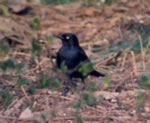
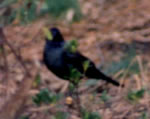
 1999-1-A
One adult male in private yards, Neutral Avenue, Staten Island, Richmond
Co., 31 Jan to 28 Feb (Henry F. Flamm). This cooperative adult male
stayed in the same suburban setting for more than a month and was frequently
heard singing from exposed positions such as treetops or roofs. The
written report by finder Henry Flamm was supported by two color photographs,
illustrating diagnostic features such as the shape and length of the
bill and the contrasting green and purple sheens of the breast and
head feathering. Thus Rusty Blackbird (E. carolinus) and other
glossy icterid species could be eliminated. Although many local birders
saw this individual during its extended stay, only one report was submitted. Photos
copyright of Henry F. Flamm. Click to enlarge.
1999-1-A
One adult male in private yards, Neutral Avenue, Staten Island, Richmond
Co., 31 Jan to 28 Feb (Henry F. Flamm). This cooperative adult male
stayed in the same suburban setting for more than a month and was frequently
heard singing from exposed positions such as treetops or roofs. The
written report by finder Henry Flamm was supported by two color photographs,
illustrating diagnostic features such as the shape and length of the
bill and the contrasting green and purple sheens of the breast and
head feathering. Thus Rusty Blackbird (E. carolinus) and other
glossy icterid species could be eliminated. Although many local birders
saw this individual during its extended stay, only one report was submitted. Photos
copyright of Henry F. Flamm. Click to enlarge.
Hoary Redpoll (Carduelis hornemanni)
1999-51-A One visiting a suburban yard, Winding Brook Drive, Guilderland,
Albany Co., 10 Dec (Walter G. Ellison, Nancy L. Martin). Described
in detail and supported by field sketches by Walter Ellison which carefully
compared its structure and plumage to the accompanying Common Redpolls
(C. flammea). A more northerly counterpart of the Common Redpoll,
Hoary Redpolls of the subspecies exilipes are subject to periodic
incursions into New York and surrounding states (Brinkley, 1998).
1999
Reports Accepted but Origins Uncertain
Common Shelduck (Tadorna tadorna)
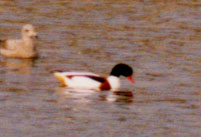
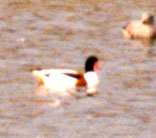
 1999-54-A
One at the Fresh Kills Landfill, Staten Island, Richmond Co., 18 Dec
(Richard R. Veit). A boldly marked and highly distinctive estuarine
duck from western Europe. Details of the sighting were supported by
color photographs by Dick Veit. Other colorful waterfowl including
other shelducks could be readily excluded. In 1998 this individual
was observed at the landfill at the same time of year but not reported
in the interim. Common Shelducks are a familiar sight in coastal areas
of Western Europe and have reached Iceland, the Azores and other Atlantic
islands. The species is therefore a reasonable candidate for vagrancy
to North America. Unfortunately, many are also kept in captivity, leaving
the origins of the Staten Island bird uncertain. That said, NYSARC
still welcomes documentation for this and similar Eurasian species.
1999-54-A
One at the Fresh Kills Landfill, Staten Island, Richmond Co., 18 Dec
(Richard R. Veit). A boldly marked and highly distinctive estuarine
duck from western Europe. Details of the sighting were supported by
color photographs by Dick Veit. Other colorful waterfowl including
other shelducks could be readily excluded. In 1998 this individual
was observed at the landfill at the same time of year but not reported
in the interim. Common Shelducks are a familiar sight in coastal areas
of Western Europe and have reached Iceland, the Azores and other Atlantic
islands. The species is therefore a reasonable candidate for vagrancy
to North America. Unfortunately, many are also kept in captivity, leaving
the origins of the Staten Island bird uncertain. That said, NYSARC
still welcomes documentation for this and similar Eurasian species.
Photos copyright of Dick
Veit.
Click images below to enlarge.
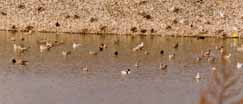

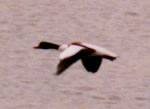
1998 Reports Accepted
Black-backed Woodpecker (Picoides arcticus)
1998-53-A One adult male in a private yard on Point Street, Cape Vincent,
Jefferson Co., 3 Oct (Mary and Brian Wood). This woodpecker was observed
at close range and in good light as it moved from tree to tree. Although
this is a relatively straightforward identification, the brevity of
this report necessitated two rounds of review. Although the description
was minimal, key points for acceptance were the solid dark back, pronounced
yellow crown patch and constant loud 'pic' call.
Hoary Redpoll (Carduelis hornemanni)
1998-16-A One at the intersection of Rts 15A and 20A, Town of Livonia,
Livingston Co., 10 Jan (Dave Tetlow); 1998-17-A One visiting a feeder
on North Hamlin Road, Town of Hamlin, Monroe Co., 22 Jan (Paul Spindler).
After two rounds of review, the Committee concluded that the key features
were in place (Czaplak, 1995).
1997
Reports Accepted
Black Vulture (Coragyps atratus)
1997-19-A One over the Braddock Bay Hawkwatch, Greece, Monroe Co., 5
May. Due to the brevity of the description, this report endured three
rounds of review. Although some key features were missing, those given
were correct for this species. Black Vultures are no longer a great
rarity in the state and have been removed from the review list (NYSARC
2000).
Reports
Not Accepted
A number of factors may contribute to a record being denied acceptance.
The most common is that the material submitted was judged as insufficient
or simply too vague to properly document the reported occurrence and
eliminate all other similar species. Written documentation or descriptions
prepared entirely from memory weeks, months, or years after a sighting
are seldom voted on favorably and the Committee cannot overstate the
importance of taking field notes. These should be taken while the bird
is under study or, if not possible, immediately afterwards. It is very
helpful to include a photocopy of these notes with the formal report.
Advice on report preparation is available on our web site (see above)
or in Dittmann and Lasley 1992. The key elements are the description
of the bird (as detailed a description as possible), the names and contact
details of the observers, location and date of the sighting and lastly
an explanation of how the identification was made. This last category
is most frequently omitted. Ask yourself the following: What features
led you to this conclusion? What other species might this bird be confused
with and how can these possibilities be eliminated? By necessity, the
preparation of a good report takes some time and effort. It is not enough
to scribble a few disjointed lines of description. Once the description
of what you saw is down on paper, it may be necessary to consult reference
books or tapes. Can you determine the age and sex of the bird? Are there
identifiable subspecies? Are there similar species? Re the latter it
is worth considering and discussing exotic possibilities (e.g. other
species of white pelican, exotic finches or wild fowl).
It is relatively uncommon for records to be rejected because the bird
was obviously misidentified. We make every effort to be as fair and objective
as possible but if the Committee is unsure about any particular submission
it tends to err on the conservative side, preferring not to accept a
good record rather than validate a bad one. All records, whether accepted
or not, remain on file and can be re-submitted to the Committee if additional
substantive material is presented. In such cases, please contact the
Secretary at the address given above.
1999
Reports Not
Accepted
Pacific Loon (Gavia pacifica)
1999-16-A One near Iona Island, Rockland Co. 15 May. A moribund loon
was initially spotted some fifty yards offshore but drifting to the
shoreline with the tide where it died. The observer and spouse took
some close-up color photographs (four submitted) of the live bird and
also recovered the specimen, which was taken to the Croton Point Nature
Center. After reviewing the photographs, the committee concluded that
this bird was in fact a Red-throated Loon (G. stellata) in basic-plumage
with a slightly deformed bill. This conclusion is based on the pale
gray cap which did not reach the eye, the very slender bill, the extensive
white sides to the neck, extensive white speckles on the wing and uppertail
coverts and distinctive peak at the rear of the head, evident in most
of the photos.
Little Egret (Egretta garzetta)
1999-10-A One on the Weesuck Creek and Shinnecock Bay in East Quogue,
Suffolk Co. 25 Apr. This was a single observer report of a species
that would constitute the first record for New York State, submitted
without photographs or other supporting documentation. Seen only once
at a distance, the description could not definitely rule out an aberrantly
plumaged Snowy Egret (E. thula).
Ross's Goose (Chen rossii)
1999-6-A Two or three Fort Miller, Washington Co. on 21 Mar. This report
lacked sufficient detail to exclude hybrid Ross's x Snow Goose (Trauger
et al. 1971; Roberson 1993).
Thayer's Gull (Larus thayeri)
1999-3-A One at Phoenix, Oswego Co., 3 Feb 1999-7-A One on the Chemung
River at the Elmira Dam, Chemung Co. 25 Mar. Perhaps more than any
other species, Thayer's Gull presents unique difficulties. To quote
a recent article on this perplexing taxon, "field identification
[of adult Thayer's Gull] is among the most problematic issues facing
birders in North America and Europe" (Howell and Elliott 2001).
Most significantly, these authors have suggested that the criteria
outlined in classic treatments (such as Zimmer 1990, 1991) and also
reiterated in popular field guides, may not be sufficient for accurate
identification of this species. Subadult plumages are similarly confusing..
The Committee has engaged in extensive debate in the hope of establishing
firm criteria for the evaluation of Thayer's Gull reports. A detailed
announcement of NYSARC's policy towards sight reports of Thayer's Gull
will be published in the near future. The Committee has followed a
conservative approach, accepting only extremely well-documented individuals
that match the classical Thayer's Gull profile in all respects.
Black Phoebe (Sayornis nigricans)
1999-15-A One at the Mohonk Lake, Ulster Co., 11 May. This brief description
of a highly contrasting flycatcher relied on reference to a field guide
illustration and did not clearly eliminate (or mention) Eastern Phoebe
(S. phoebe). There are currently no accepted records of Black
Phoebe for New York State or northeastern North America.
Fork-tailed Flycatcher (Tyrannus savana)
1999-28-A One near the intersection of Mineah and Mt. Pleasant Roads,
Town of Freeville, Tompkins Co., 13 Aug. This report from a traveling
birder lacked several critical details and could not satisfactorily
eliminate commoner species such as Eastern Phoebe (Sayornis phoebe)
or Eastern Kingbird (T. tyrannus) with aberrant tail feathers.
Northern Wheatear (Oenanthe oenanthe)
1999-34-A One Forked Lake Campground off North Point Road, Town of Arietta,
Hamilton Co., within the Adirondack Park, 4 Oct. Several details of
this very brief report were inconsistent with a wheatear of any kind.
Le Conte's Sparrow (Ammodramus leconteii)
1999-27-A One in East Quogue, Suffolk Co., 10 Aug. This Ammodramus sparrow
was described in detail, although it was studied for an estimated total
of six seconds. The Committee was troubled by the surprisingly early
date (assuming a fall migrant) and felt that the report did not adequately
address the likely potential for confusion with juvenile plumages of
other Ammodramus species also present in this area in late summer.
Blue Grosbeak (Guiraca caerulea)
1999-13-A One at a private residence Town of Chatham, Columbia Co., 9
May. This weak report provided almost no detail of the bird's plumage,
bill or size and made it impossible to exclude similar species such
as Indigo Bunting (Passerina cyanea).
1998
Reports Not Accepted
Yellow-nosed Albatross (Thalassarche chlororhynchos)
1998-43-A One approximately 21 miles southeast of Fire Island Inlet (coordinates
26435.1, 43676.5) Suffolk Co.,12 Jul. This report was submitted by
a birder on a scuba diving trip. The bird approached the anchored dive
boat and was studied for about two minutes before flying off. The report
did not describe the flight style and made a casual reference to a
'second bird' which was not described further. After two rounds of
review, the Committee concluded that the details provided were insufficient
to unequivocally identify this as an Yellow-nosed Albatross. That said,
several Committee members felt that the description was consistent
with one of the small albatrosses.
Sandhill Crane (Grus canadensis)
1998-79-A, One at Mendon Ponds Park, Mendon, Monroe Co., 17 May. This
report comes from an experienced observer and may well have been correct.
However, the bird was heard calling several times but not seen. While
the vocalizations of Sandhill Cranes are relatively distinctive, Committee
members were troubled by the description of this call as 'rattling'.
It is also unclear whether exotics such as Common Crane (Grus grus)
or Common x Sandhill Crane hybrids can be eliminated on call alone.
Rough-legged Hawk (Buteo lagopus)
1998-34-A One off Route 78 between Java Village and Strykersville, Co.,
10 Jul. This was a very brief sighting made from a moving vehicle.
Relatively common during the winter months, records of this species
in the summer are exceptional. The Committee felt that under these
unusual circumstances the details supplied in the report were insufficient
to eliminate other buteos, particularly first-year Red-tailed Hawk
(B. jamaicensis).
Gyrfalcon (Falco rusticolus)
1998-54-A One in East Quogue, Town of Southampton, Suffolk Co., 5 Oct.
This bird was observed very briefly as it flew past the observer using
shallow flaps interspersed with longish glides on set wings. The Committee
was troubled by the relatively early date, the incomplete description
and failure to consider alternatives such as Northern Goshawk (Accipiter
gentilis) or escaped falconry birds.
American Avocet (Recurvirostra americana)
1998-47-A One on Myer's Point, Tompkins Co., 24 Aug. Although this should
be a straightforward identification, the Committee was forced to reject
the report after two rounds of review. The stumbling block was the
perplexingly thin description. Neither the written description nor
the sketch that was provided made any reference to an upturned bill,
a hallmark of this species. Sadly, this bird was seen by multiple observers
but no additional reports were received This is a prime example of
why multiple submissions, when possible, are so essential.
Thayer's Gull (Larus thayeri)
1998-1-A One first basic at Oswego Harbor, Oswego Co., 25 Jan; 1998-11-A
One adult on the Seneca River, Baldwinsville, Onondaga Co., 28 Jan;
1998-23-A One immature bird on Long Pond, Greece, Monroe Co., 10 Mar;
1998-42-A One at the Shinnecock Inlet, Suffolk Co., 6-8 Jun. As discussed
above, the identification of Thayer's Gulls presents a unique problem
for birders in eastern North America. The criteria needed for separation
of true Thayer's Gulls from intergrades with the Kumlien's form of
Iceland Gull (L. glaucoides) are still poorly understood. It
is the belief of the Committee that a feather by feather analysis,
preferably supported by a suite of photographs, is required for safe
identification. A more thorough analysis of this vexing identification
and taxonomic problem and justification of the rigorous stance taken
by the current Committee will be published at a future date. We wish
to commend the observer of the Oswego and Seneca River birds for a
notably valiant attempt at documenting these difficult but fascinating
gulls.
California Gull (Larus californicus)
1998-3-A One at the southwest corner of Seneca Lake, Schuyler Co., 11
Feb. Described as an adult in transition from basic to alternate plumage.
After two rounds of review, the Committee concluded that the report
contained insufficient description of wing tip pattern and head/neck
streaking and relied too heavily on the bill pattern and presence of
a dark eye, neither of which are definitive. The Committee was also
concerned by the similarity of the bird's size and mantle coloration
to Ring-billed Gull (L. delawarensis).
Summer Tanager (Piranga rubra)
1998-37-A One Point Street, Cape Vincent, Jefferson Co., 15 May. Described
as an immature male, the identification was based primarily on bill
size. No details of the wings, mantle color or bill shape were provided.
1997
Reports Not Accepted
Brewer's Blackbird (Euphagus cyanocephalus)
1997-16-A One near Mecklenburg, Schuyler Co., 7 and 10 Apr. The Committee
was troubled by causal references to multiple occurrences of this species
and the subspecies of Common Grackle (Quiscalus quiscula stonei),sometimes
referred to as the "purple" grackle, which is rare so far
inland. Although the bird was photographed, copies have not been made
available to the Committee.
Reports
Pending
The following reports are retained for a third circulation. This means
the Committee has not yet reached a final decision on these reports:
Pacific Loon (Gavia pacifica)
1998-75-A, One, Black River Bay, Township of Hounsfield, Jefferson Co.,
29 Dec 1998.
American White Pelican (Pelecanus erythrorhynchos)
1999-24-A Two over Cornell University, Ithaca, Tompkins Co., 12 Jul 1999.
Sandhill Crane (Grus canadensis)
1998-80-A, One off Redman Road, Brockport, Monroe Co., 23 May 1998.
Black Vulture (Coragyps atratus)
1998-24-A One over Braddock Bay, Greece, Monroe Co., 27 Mar 1998.
Thayer's Gull (Larus thayeri)
1999-48-A Two on Niagara River, Robert Moses Power Plant, Town of Lewiston,
Niagara Co., 29 Nov1999; 1999-50-A One on Niagara River, Goat Island,
Niagara Falls, Niagara Co., 6 Dec 1999.
Ivory Gull (Pagophila eburnea)
1999-5-A One at Kenny's Beach, Town of Southold, Suffolk Co., 13 Mar
1999.
Loggerhead Shrike (Lanius ludovicianus)
1999-29-A One off Road 60, Town of Van Buren, Onondaga Co., 13 Aug 1999.
Submitted on behalf of the New York State Avian Records Committee,
|
Angus Wilson (Chair)
Jeanne Skelly (Secretary)
Robert Andrle
Thomas W. Burke
Willie D'Anna
Kevin J. McGowan
Robert O. Paxton
Gerard Phillips
|
Observers
NYSARC gratefully acknowledges the contributions of the following observers
who submitted written and/or photographic documentation:
Lawrence Alden, , John B. Bounds, Joseph Brin, Robert E. Budliger, Linda
Carrington, Carolyn T. Cass, David J. and Candis C. Cesari, Lee Chamberlaine,
Dorothy Crumb,Willie D'Anna, Karl David, Joe DiCostanzo, Peter Dorosh,
Dale Dyer, Tom Dudones, Lenore and Vern Durkee, Walter G. Ellison, Benjamin
Fambrough, Steve Fast, Shawneen Finnegan, Henry F. Flamm, Donald Ford,
John J. Fritz, Michael D. Galas, Yolanda Garcia, Arie Gilbert, John A.
and Sue Gergoire, Kevin C. Griffith, Andrew Guthrie,Diane Henderson,
Michael Higgiston, David J. Hoag, Joel L. Horman, Brendan Klick, Patricia
Kocinski, Wayne Kocher, William E. Krueger, Anthony J. Lauro, Nick Leone,
Nancy L. Martin, Randi Minetor, Steve Nanz, Jack Passie, Gerard Phillips,
Anthony and Beverley Prentice, Bill Purcell, Barbara Putnam, Joan Quinlan,
Gerry Rising, Margaret S. Rusk, Dave Russell, Tom Salo, Eric Salzman,
Catherine I. Sandell, Richard Sowinski, Cathy Spahn, Robert G. Spahn,
Paul Spindler, Larry Springsteen, Rex G. and Birgit Stanford, Dave Tetlow,
Alison E. Van Keuren, Richard R.Veit, William W. Watson, Angus Wilson,
Chris Winters, Mary and Brian Wood, Dick Young, C. Kendall Zoller.
Literature Cited
American Ornithologists' Union (1998) Check-list of North American birds,
7th ed. American Ornithologists' Union, Washington, D. C.
Birol, O. (1999) The first documented breeding of Blue Grosbeak on Long
Island and second in New York State. The Kingbird 49(3): 186-189.
Brinkley, E. S. (1998) Hoary Redpoll (Carduelis hornemanni) in
Bull's Birds of New York State (E. Levine, editor). Comstock Publishing
Associates, Ithaca and London.
Czaplak, D.(1995) Identifying Common and Hoary Redpolls in winter. Birding
27: 447-457.
D'Anna, W. (2000) Gulls on the Niagara Frontier: An update. The Kingbird 50(3): 206-222.
Dittmann, D. L., and G. W. Lasley (1992) How to document rare birds.
Birding 24:145-159.
Garner, M. and A. McGeehan. (1998) Identification of juvenile and first-winter
Thayer's Gull. Birding World 11(3): 94-101.
Guthrie, A., A.Wilson. and A. Lauro (1999) Eurasian subspecies of Mew
Gull (Larus canus canus) on Long Island. The Kingbird 49(4): 286-294.
Howell, S. N. G. and M. T. Elliot (2001) Identification and variation
of winter adult Thayer's Gulls with comments on taxonomy. Alula 4: 130-144.
Lethaby, N. and J.Bangma. (1999) Black-tailed Gull in North America:
some notes on identification. Birding 31: 57-64.
McGowan, K. J. and T.W.Burke (2000) Report from ad hoc committee to
revise NYSARC guidelines. Kingbird 50: 25-27
NYSARC (2000) Changes to the NYSARC review list. Kingbird 50: 27-33
Phillips, G. (1998) Yellow-billed Loon in Oswego Harbor. Second state
record. First live sighting! Kingbird 48: 98-102.
Roberson, D. (1993) A note on hybrid white geese: A cautionary tale.
Birding 25:50-53.
Ryder, J. P., and R. T. Alisauskas. 1995. Ross' Goose (Chen rossii).
In The birds of North America, No. 162 (A. Poole and F. Gill, eds.).
The Academy of Natural Sciences, Philadelphia, and The American Ornithologists'
Union, Washington.
Trauger, D.L., A. Dzubin, and J.P. Ryder. (1971) White geese intermediate
between Ross' Geese and Lesser Snow Geese. Auk 88:856-875.
Treacy, E. D. (1983) Ross' Goose added to New York State list. Kingbird 33: 153-154.
Veit, R. R. and M. E. Taylor (2000) First record of MacGillivray's Warbler
for New York State. The Kingbird 50(1): 2-6.
Wilson, A. and A Guthrie (1999) Black-tailed Gull (Larus crassirostris)
at Jones Beach, Nassau County 31 Jan-1 Feb 1999; First record for New
York State. Kingbird 49: 2-7.
Zimmer, K. J. (1990) The Thayer's Gull complex. Pp 114-130 in Kaufman,
K. (1990) A Field Guide to Advanced Birding. Houghton Mifflin, Boston
Mass.
Zimmer, K. J. (1991) Plumage variations in "Kumlien's" Iceland
Gull. Birding 23: 254-269.

